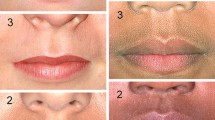Summary
The proportions of chromosomal genotypes associated with the Turner syndrome genotype (excluding those with a Y chromosome) in embryonic and fetal deaths, in fetuses diagnosed prenatally, and in living individuals were reviewed. The ratio of apparent non-mosaic 45,X to 45,X/46,XX mosaics was notably higher in a New York City series of embryonic and fetal deaths, 13.5 to 1, than in living individuals reported to the New York State Chromosome Registry, 3.6 to 1. The ratios of 45,X cases to those with 46,Xi(Xq) was 5.7 to 1 in living individuals, but was 112 to 0 in embryonic and fetal deaths, an even greater disparity, indicating the marked fetoprotective effect of more than one dose of some locus or loci on the long arm of the X chromosome. The results of review of data pertinent to the livebirth prevalence of the (apparent non-mosaic) 45,X geno-type suggest a rate of about 5.7 per 100,000 livebirths (11.8 per 100,000 females) with 95% confidence limits of 2.6 per 100,000 to 10.8 per 100,000. The rate in fetuses diagnosed prenatally is 8/27,202, about 30 per 100,000. As a large proportion of these, perhaps 75%, would undergo spontaneous fetal death if not terminated electively, these figures are consistent with the direct estimate of livebirth rates. The rate of all those with X chromosome abnormalities (without a Y chromosome) associated with signs or symptoms that eventually lead to referral for cytogenetic study was estimated at a minimum of 10.7 per 100,000 livebirths, (22.2 per 100,000 females).
Similar content being viewed by others
References
Barr ML (1962) Discussion, symposium on sex chromatin. Acta Cytol 6:51–52
Bell AG, Corey PN (1974) A sex chromatin and Y body survey of Toronto newborns. Can J Genet Cytol 16:239–250
Burns JL, Hall JC, Powers E, Callis JB, Hoehn H (1979) No evidence for chromosomal mosaicism in multiple tissues of 10 patients with 45,XO Turner syndrome. Clin Genet 15:22–28
Ferguson-Smith MA (1962) Discussion, symposium on sex chromatin. Acta Cytol 6:51–52
Ferguson-Smith MA (1965) Karyotype-phenotype correlations in gonadal dysgenesis and their bearing on the pathogenesis of malformations. J Med Genet 2:142–156
Ferrier PE, Ferrier SA, Kelley VC (1970) Sex chromosome mosaicism in disorders of sexual differentiation: incidence in various tissues. J Pediatr 76:739–744
Hecht F, Maciarlane JP (1969) Mosaicism in Turner's syndrome reflects the lethality of XO. Lancet ii:1197–1198
Hook EB (1983) Chromosome abnormalities and spontaneous fetal death following amniocentesis: further data and associations with maternal age. Am J Hum Genet 35:110–116
Hook EB, Hamerton JL (1977) The frequency of chromosome abnormalities detected in consecutive newborn studies—differences between studies—results by sex and by severity of phenotypic involvement. In: Hook EB, Porter IH (eds) Population cytogenetics—studies in humans. Academic Press, New York, pp 63–79
Hook EB, Liss SM (1982) Age of ascertainment—a relative index of severity of cytogenetic disorders. J Chrom Dis 35:207–209
Hook EB, Cross PK, Schreinemachers D (1981) The evolution of the New York State Chromosome Registry. In: Hook EB, Porter IH (eds) Population and biological aspects of human mutation. Academic Press, New York, pp 389–428
Maclean N, Harnden DG, Court Brown WM, Bond J, Mantle DJ (1964) Sex chromosome abnormalities in newborn babies. Lancet i:286–290
Marden PM, Smith DW, McDonald MJ (1964) Congenital anomalies in the newborn infant, including minor variations. J Pediatr 64:357–371
Robinson A, Goad WB, Puck TT, Harris JS (1969) Studies on chromosome non-disjunction in man. III. Am J Hum Genet 21:466–485
Santana JAM, Gardner LI, Neu RL (1977) The X isochromosome-X syndrome (46,Xi(Xq)). Clin Pediatr 16:1021–1026
Warburton D, Yu CY, Kline J, Stein Z (1978) Mosaic autosomal trisomy in cultures from spontaneous abortions. Am J Hum Genet 30:609–617
Warburton D, Stein Z, Kline J, Susser M (1981) Chromosome abnormalities in spontaneous abortion: data from the New York City study. In: Porter IH, Hook EB (eds) Human embryonic and fetal death. Academic Press, New York, pp 261–287
Author information
Authors and Affiliations
Rights and permissions
About this article
Cite this article
Hook, E.B., Warburton, D. The distribution of chromosomal genotypes associated with Turner's syndrome: livebirth prevalence rates and evidence for diminished fetal mortality and severity in genotypes associated with structural X abnormalities or mosaicism. Hum Genet 64, 24–27 (1983). https://doi.org/10.1007/BF00289473
Received:
Issue Date:
DOI: https://doi.org/10.1007/BF00289473




